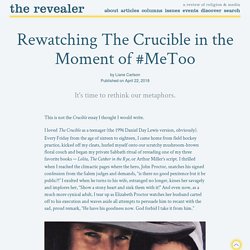

SalemWitchMockTrial 2scripts. THE CRUCIBLE by Arthur Miller. Why witchcraft is making a comeback among US feminists. The Crucible Plot Summary. The Crucible 1996 Trailer. Rewatching The Crucible in the Moment of #MeToo — The Revealer. This is not the Crucible essay I thought I would write.

I loved The Crucible as a teenager (the 1996 Daniel Day Lewis version, obviously). Every Friday from the age of sixteen to eighteen, I came home from field hockey practice, kicked off my cleats, hurled myself onto our scratchy mushroom-brown floral couch and began my private Sabbath ritual of rereading one of my three favorite books — Lolita, The Catcher in the Rye, or Arthur Miller’s script. I thrilled when I reached the climactic pages where the hero, John Proctor, snatches his signed confession from the Salem judges and demands, “is there no good penitence but it be public?!” I exulted when he turns to his wife, estranged no longer, kisses her savagely and implores her, “Show a stony heart and sink them with it!” But about halfway through watching it last month, I turned to my husband, stretched out on our ratty black futon next to me, and voiced the thought that had been building for an hour.
And it is. Liane F. The Crucible by Arthur Miller. The Crucible by Arthur Miller. Witches are some of the most enduring feminist icons of our time. The specter of the witch haunts both fact and fiction.

She is all at once wizened hag, poison apple in hand; learned spinster, married to her books; and enchanting seductress with bared breasts and hypnotic stare. Although she may inhabit the same pop culture pantheon as vampires, zombies, and werewolves, the witch has long been a symbol of fear not because she can harness forces that transcend this mortal coil, but because she embodies the a powerful femininity free from male influence or ownership. First, Kill the Witches. Then, Celebrate Them. HOLIDAYS restore us, reassure us and remind us of who we are — a reason some of us hesitate to head home for Thanksgiving.

They also tend to develop by accretion and misconception. While we like to think them wholesome and organic, they more resemble our breakfast cereals; an awful lot of fluorescent marshmallow charms have crept in among the toasted oats. St. Valentine never met a metallic red Cupid. The Pilgrims would be astounded to discover they laid any claim to the fourth Thursday in November. Even allowing for an especially American elasticity, you have to engage in some wacky contortions to come up with Halloween, a holiday most of us would be hard-pressed to explain.
Image Insofar as we can chart its murky origins, Halloween derives from Samhain, an ancient Celtic harvest festival. That the least decorous, most disorderly of holidays should have established permanent residence in eastern Massachusetts is incongruous on any number of counts. The holiday isn’t for everyone. ‘The Blair Witch Project’ at 20: Why It Can’t Be Replicated. More than a year before “The Blair Witch Project” hit theaters and became a cultural phenomenon, its central mystery had already gone viral.

According to the movie’s fledgling promotional website, which presented itself as a real investigative project, three film students — Heather, Mike and Josh — had ventured into the Maryland woods in 1994 to shoot a documentary and then disappeared. Their footage was recovered a year later, providing evidence to support a disturbing legend. Are Witches Real? The Witches: Salem, 1692 - Stacy Schiff. 21078735 The Crucible Arthur Miller 2hmdzot. Colonial America for Kids: Salem Witch Trials. History >> Colonial America The Salem witch trials were a series of prosecutions in which over 200 people were accused of practicing witchcraft.

They took place in a number of cities in Massachusetts Bay Colony in the years 1692 and 1693, but primarily in the town of Salem. Salem Witch Trials from William A. Crafts Did the people really believe in witches? During the late 17th century, the Puritans of New England believed that witchcraft was the work of the devil and was very real. What started the trials? The witch trials in Salem began when two little girls, Betty Parris (age 9) and Abigail Williams (age 11), began to have strange fits. The girls blamed their condition on witchcraft. Mass Hysteria. Salem Witch Trials: History and Background. We often hear terrible stories of the Salem Witch Trials, and certainly, some members of the modern Pagan community toss out the Salem case as a reminder of the religious intolerance that has existed for centuries.

But what really happened in Salem, back in 1692? More importantly, why did it happen, and what changes did it bring about? The Colony The witch trials stemmed from accusations made by a group of young girls that various townsfolk, including a black slave, were in cahoots with the Devil. Although the list of specifics is far too detailed to go into here, it’s important to note that there were many factors that came into play at the time. Salem was also a fairly litigious sort of town, and neighbors constantly battled with neighbors over things like where a fence should be put, whose cow ate whose crops, and whether or not debts were paid in a timely fashion.
Colonial America for Kids: Salem Witch Trials.